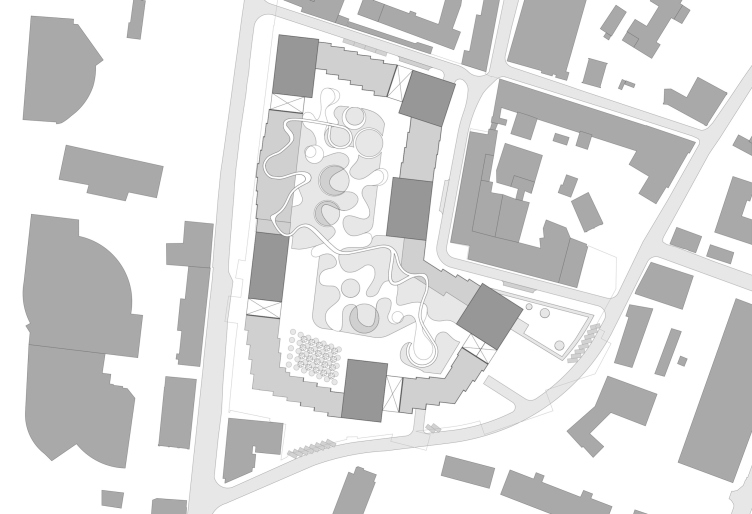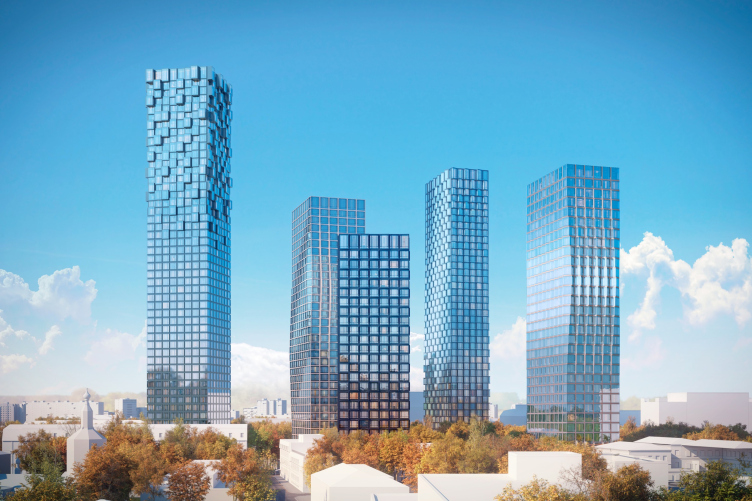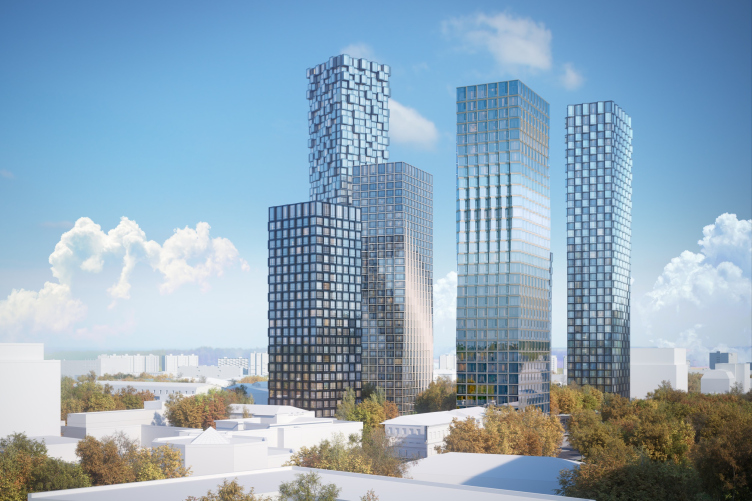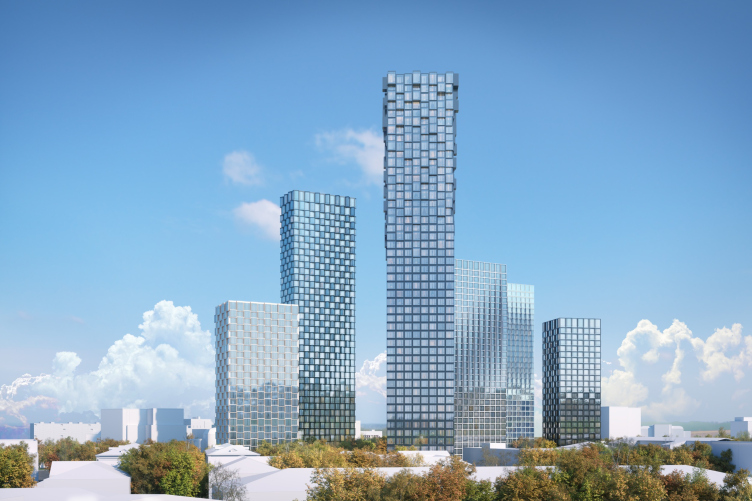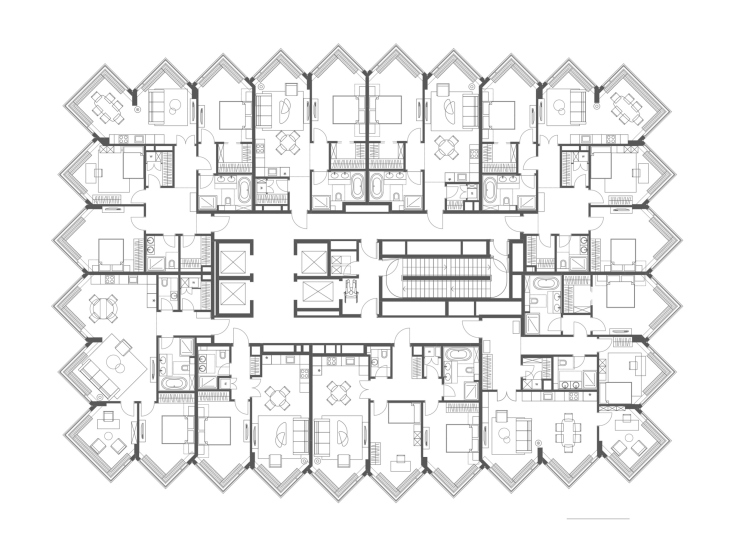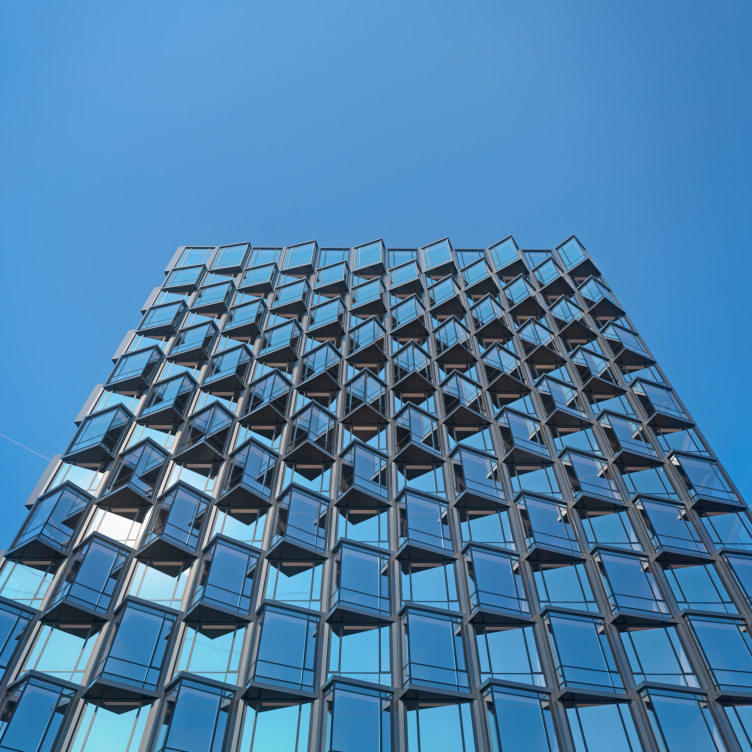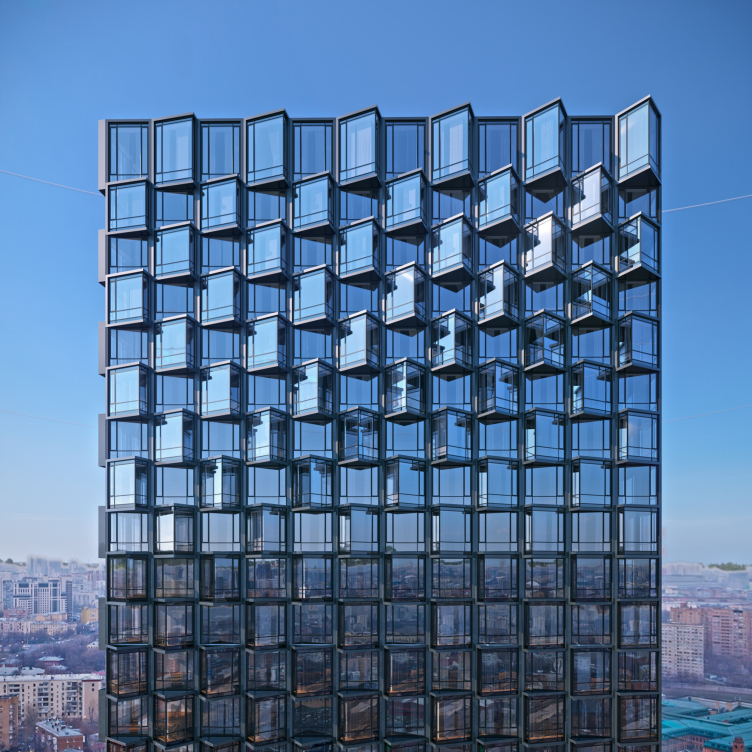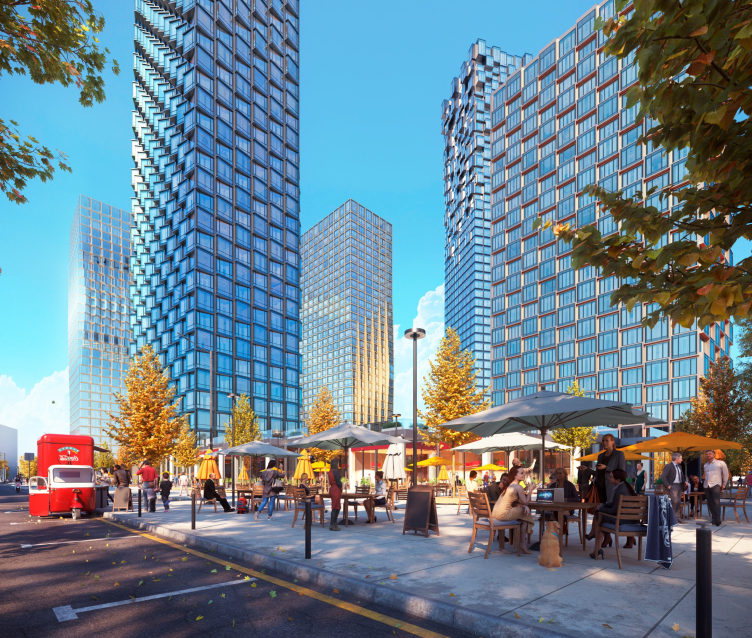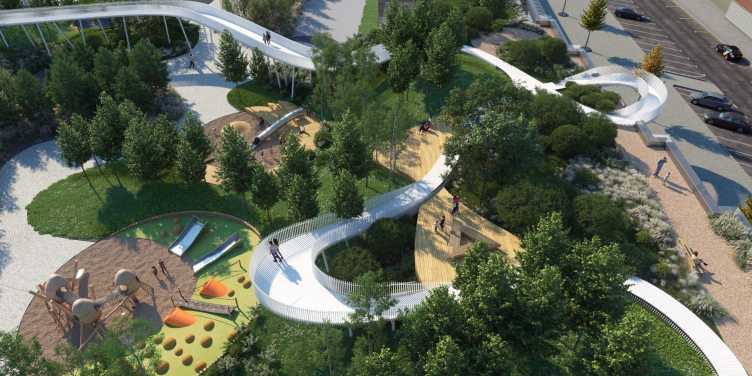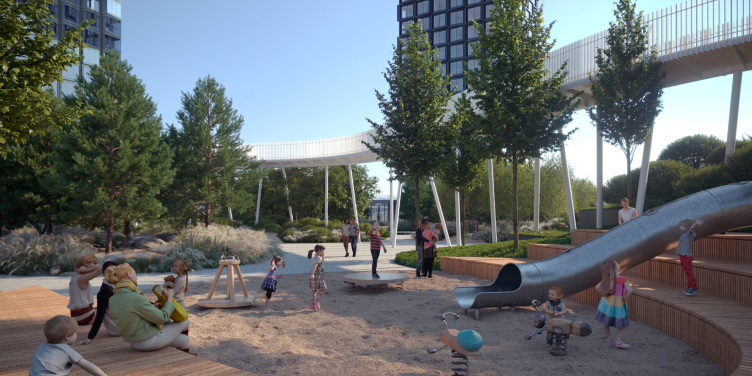The complex is situated in the former Paveletskaya industrial estate, one of the territories where still in the 1990s Moscow began transforming former factories into postindustrial urban spaces. Today, the reconstruction of the railway station square is being completed, which must finally give shape to the “city facade” of the Paveletskaya Railway Station. At the same time, the construction of office complexes and projects of reconstructing factory buildings into business parks gradually gave way to large-scale high-rise housing projects. Two new towers will be built in the stead of Cold Storage Facility #3 on Dubininskaya Street; a little further down south, the high-rise housing complex “Paveletskaya City”, 46 stories high, is being built; between the Zhukov Drive and Derbenevskaya Street, still another housing is being built by PIK developers.
The HIGH LIFE land site is one of such narratives on Paveletskaya. Its very location, on the territory of a former tannery of the 19th century, is one of the most advantageous. First of all, it is just a 10 minutes’ walk away from the Paveletskaya metro station. In addition, most sites around it have already been developed by business centers (the largest of them being Vivaldi Plaza) and even high-end residential complexes; this place already has a city life with a relatively comfortable environment. At the same time, the land site is located east of Letnikovskaya Street, and is separated from the railroad line by city blocks on its opposite side.
The housing complex “High Life Letnikovskaya”
Copyright: © ADM
This location, advantageous and conspicuous in many respects, called for a flashy design solution. A thousand and a half apartments are housed in six glass towers, evenly spaced along the perimeter of the site. The architects came to the idea of towers at once: the complex is big, and the high-rise volumes make it possible to avoid the heaviness of “slab” houses and find a slender silhouette, which is important for distant perception – notes the leader of ADM, Andrey Romanov.
Initially, all the six towers were of equal height, 120 meters, according to the site’s height limit, and alternated three facade variants. Later on, however, the Moscow government cancelled the restrictions. The architects received an opportunity to build up the towers, housing the same square footage in volumes with more diverse silhouettes.
We had quite an interesting 2020: there were many high-rise projects, we tried new aesthetics and tackled challenges that the city posed to us. The residential complex on Letnikovskaya Street develops our search for the typology of the glass skyscraper, a search that is oftentimes intuitive. I am convinced that when designing, you need to follow your own feelings and ideas about modern life – this is a source of inspiration just as good as any other. It is also important to note the contribution of the city government, which met us halfway and for the sake of expressiveness of the composition lifted the height restrictions.
The towers received different heights – from 24 to 48 floors (89 and 186 meters respectively). If we are to study them consecutively, following the skyline of the complex, the height rises and drops, sometimes smoothly, and sometimes abruptly. The two tallest buildings – on the corner turned into the yard, the other on Letnikovskaya Street – stand in the east and west. In the north and south stand towers of a lower height.
As a result, when viewed from different vantage points, the skyline of the complex will change. When viewed from the Krasnokholmsky Bridge and the high-rise of the House of Music – from the north – the volumes will be partially juxtaposed, “flocking together” in a compact block. From the Garden ring and the Paveletskaya Station, the silhouette will stretch horizontally, displaying “cesura” breaks between the towers.
The housing complex “High Life Letnikovskaya”. View from the north
Copyright: © ADM
The housing complex “High Life Letnikovskaya”. View from the northeast
Copyright: © ADM
From the side of the Moscow River, however, the group of buildings takes on a “pyramidal” silhouette, and the part of “the first violin” and the symmetry axis is played by tallest tower, standing at the inner corner of the land site, closer to the Derbenevskaya Street. All the volumes stand on its sides, and the outline of their composition – just the outline! – viewed from this angle, looks like the silhouette of the high-rise, something like a shadow of the Stalin tower on the Kotelnicheskaya embankment, divided in space by vertical strokes. If you sail down the river from the city center southward, this effect will be particularly strong.
The housing complex “High Life Letnikovskaya”. View from the southeast
Copyright: © ADM
At the same time, from this side the complex is establishing connections with other mega-projects of this city – the River Sky housing complex on the Simonovskaya Embankment and the remote, yet still taller, South Port. All of them will find themselves on one axis running from southeast to northwest, and, when implemented, will become parts of the same “chain” of new high-rise centerpieces that will fill in the arc alongside the already existing ones: the House of Music and the Kotelnicheskaya high-rise.
The most interesting thing in this project, however, is the diversity of the glass towers, each of which got its own sculptural relief. The one thing that the facades of all the buildings have in common is glass: everywhere we see large panoramic windows not just from floor to ceilings but also the entire width: all of them are encased in slender metallic frames, whose material is not even always felt like an important element of the architectural solution – glass really steals the show. The houses look as if they were composed of myriads of glass cells. They are arranged in a regular fashion, but in “highlight” places they come into motion: the main tower is “split” and opens up in a pixel-like pattern, like a flower, in its upper part. The two towers in the north part (32 floors, 115 meters tall each) have a wave running across them, as if somebody ran their finger over a set of toy construction blocks, making some of them consecutively pivot on their axis. What’s interesting is the fact that even in the corners there is no prominent outside frame; it is planned to hide the facet of outward glazing in order to create the impression of glass cubes turning.
The facades of the lowest buildings (24/25 floors, 89m), situated in the “apogees” of the site, black in the north and light-colored in the south, are designed as a relief, but regular enough alteration of ledges and recessions.
On the other hand, the tower on Letnikovskaya Street, the second-highest one, 39 floors, 142 meters tall, is all “astir” from top to bottom, getting a totally zigzag contour in its top floors. It’s even difficult to say which of the two towers is the main one here: while the tallest building is designed for the dialogue with remote points of the city, and, therefore, opens up in its upper part, this other tower, standing on the street, serves as a representative of the complex, and is designed for various angles of perception, both from a close and distant range.
The housing complex “High Life Letnikovskaya”. Plan of Tower K1
Copyright: © ADM
The plastique of Tower 6 is also based on checkerboard alternation, but the ledges not just protrude but turn at different angles, forming a semblance of a wave, reserved on the side end facades, and wild and soaring on the main facade, the street and the yard ones, bristling with triangles if you look from down below.
The housing complex “High Life Letnikovskaya”
Copyright: © ADM
The housing complex “High Life Letnikovskaya”
Copyright: © ADM
Therefore, it comes as no surprise that the website of the complex characterizes it in this nutshell: “the image of the buildings is a set of visions that reflect our notion of modern life”. Indeed, ADM architects turned this project into a research of what a cutting-edge glass house could be. The facades do not display so much as a hint at the traditional rock face texture, porcelain stoneware, or brick, not a trace of retro. At the same time, “pure” Wright-esque glass would have been too much of an obvious solution. And if it were “totally sculptural” – for example, like one big spiral – it would have probably created a wow-effect but it would have been too expensive for a housing project. This is how this “one of a kind” set of glass elements came about, which displays the inner essence of the buildings composed of “cell” apartments, and reflecting in its shape the “multi-apartment” nature of big city life – and at the same time technologically advanced, expensive-looking, and forming glittering waves that is capable of arresting your gaze and mesmerizing you.
If we are to add to the diverse plastique of the facades the fact that they will be inevitably changing depending on the weather and lighting, we can say that the number of viewing angles is indefinite.
Climbing down from the “skies” of the top floors to the “earth” of the yard, the residents will be faced with yet another unconventional solution. All the towers are linked by a single-story retail gallery that not only limits access to the private yard but also livens up the streets with the energy of a big city. Cafes, gyms, and beauty salons will be popular not just among the residents of the complex but also among the coworkers of the business centers that are, as was already said, abundant around here.
The housing complex “High Life Letnikovskaya”
Copyright: © ADM
Some of the gallery in the depth of the block will be occupied by a kindergarten for 200 kids; yet another segment will be made into a resident club with a movie theater, a library, a coworking space, a children’s room, and a terrace. This is not the whole of it, however.
The retail gallery is good for forming an urban environment, but for the yard territory it’s rather a problem because of its dull back wall, which is at best “adorned” by the windows of the technical rooms. ADM finds an elegant solution, covering the back wall with artificial hills. A similar technique was already tested by the architects, albeit on a smaller scale, in the housing complex Renome on Novoslobodskaya. In Renome, however, the “hill” is on just one side, and here it runs along the entire perimeter, thanks to which the yard turns into a green valley without so much as a hint at the street bustle outside, and new landscaping possibilities appear: the hills are connected by bridges, which form a second tier, while down below recreational grounds appear. Also important is the fact that the yard is totally barrier-free.
The housing complex “High Life Letnikovskaya”. The yard
Copyright: © ADM
The housing complex “High Life Letnikovskaya”. The terraced bench and the sandbox
Copyright: © ADM
Thus, the project not only meets the declared premium class of real estate, but represents it, manifesting the task in its artistic features. Starting with a versatile approach to the public spaces of the lower tier – on one side a city, on the other a garden – and ending with carefully sculpted facades from cubes of expensive glass.
“The market shows that panoramic facades are now a trend in premium housing, says Andrey Romanov – A sign of high status and lifestyle, provided with the capabilities of current technologies. It also works for a new approach to form, modern and prestigious. Ultimately, the image of the building is a set of visions that reflect our notion of modern life, imbued with motion and the energy of a big city”.




